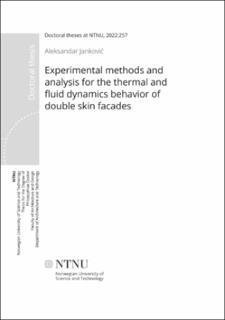| dc.description.abstract | The concept of a modern double-skin façade (DSF) as we know it today has been around for more than 100 years since the idea of Le Corbusier’s active glass wall, although the origins of this design can be recognized far earlier in vernacular architecture. However, it is only in the last 30 years that the application of DSFs in buildings has become more common, indicating the lack of established building practice, best reflected in the frequent occurrence of the dual nature (behavior) of the DSF in practice. On one side, flexible control of mass and energy fluxes between indoor and outdoor environments offered by DSFs enables far better performance than static single-skin envelopes in terms of energy demand and thermal, visual, and even acoustic comfort. The other side of the coin is reflected through a necessity for proper design and constant administration, which, if not done correctly, can lead to a drastic underperform, even compared to conventional envelopes. Transport of mass, momentum, and energy (heat and light) highly interact with each other. In addition, they are non-linear in DSF systems due to their constant interaction with the varying boundary conditions and construction features. Therefore, it is not straightforward to link and quantify the influence of construction features, operational modes, and environmental conditions on the thermophysical behavior of DSFs. Systematic investigations allow comprehensive and reliable insights into such cause-and-effect relationships, but there are insufficient examples, which is the main reason why these links are not fully understood.
This doctoral research aims to expand the knowledge on thermal and fluid dynamics behavior of DSFs and quantify how this behavior is influenced by the construction elements and boundary conditions. As the most fundamental and reliable way of obtaining new knowledge, an experimental approach has been chosen to accomplish this, which had to be systematic to ensure the comprehensiveness of the results. Through several experimental campaigns, both in the field and in a controlled environment, the performance of real-scale DSF mock-ups has been monitored. Given that DSFs do not have a long building tradition and, at the same time, exert complex behavior atypical for conventional envelopes, their performance assessment and measurement procedures are underresearched or non-standardized. Moreover, the standard metrics for traditional envelopes are not suitable to describe the dynamic behavior of DSFs, so distinctive performance indicators were used to address these issues. Therefore, this doctoral research additionally seeks to improve the methodological approach to conducting experiments to enable a more comprehensive and reliable characterization of DSF behavior. The findings from this aspect of the research are equally important since without proper experimental design, setup, and execution, valid conclusions about thermal and fluid-dynamics behavior cannot be drawn.
The state-of-the-art review in Chapter 2 frames the research by systematically depicitng current knowledge about the cause-and-effect relationships between construction features, boundary conditions, and thermophysical behavior of DSFs. In addition, an overview of both experimental and numerical methods appropriate for such investigation is provided. The outcomes of this activity inform the direction of the present research. More precisely, what aspects of the thermophysical behavior need to be studied and how this should be done. Accordingly, in the second stage of the research, an experimental testbed was developed to allow comprehensive and systematic testing of DSFs in a controlled environment. The assembled testbed was verified with experimental investigations of various levels of complexity suitable for different types of characterizations. It was concluded that for the developed flexible experimental testbed, the design of the experiment (DOE) method is most appropriate to systematically characterize the thermophysical behavior of a DSF. Therefore, in the following research activity, the focus was placed on optimizing the selected methodology to make the most of the experimental testbed. An extensive simulation study with nearly half a million simulations resulted in the recommended course of action for finding the optimal experimental design suitable to characterize the targeted complex behavior using resource-limited experiments.
The developed methodological approach using building performance tools and simulations was validated in the following research stage with the real ‘physical’ experiments in a climate simulator. An equally important result of this experimental campaign was the assessment of the impact of construction features and boundary conditions on the thermal and fluid-dynamics behavior of a single-story DSF naturally ventilated in a wide range of boundary conditions typical of summer. The analysis results indicated that the central regulators were environmental factors, while the influence of controllable features (venetian blinds and the opening size) was considerably limited. However, some aspects of behavior, such as net heat transfer and even the airflow rate, could be controlled by adjusting the angle of venetian blinds. Another experimental campaign in a climate simulator was conducted with the single-story DSF to examine the efficiency of mechanical ventilation and venetian blinds in controlling heat transfer. It was found that mechanical ventilation effectively relieved the thermally-overloaded DSF cavity but did not significantly reduce the net heat penetrating the indoor environment. Regarding air preheating, relatively low airflow rates were able to deliver enough fresh air and sufficiently preheated air, while any higher rates of supplied air significantly increased the energy required to keep the constant interior temperature. The way in which the research activities are related to the research questions, publications, and the overall objective of the doctoral study is provided in the graphical abstract given below.
This thesis comprises several articles set as chapters, connected and arranged to coherently follow the course of the conducted research. The collection of articles is preceded by an introduction that discusses the theoretical background, defines the problem, and presents the overall goal, research questions, and the methodology of the study. The last chapter discusses the results of the study and provides answers to previously defined research questions, and also reflects on the limitations of the research. Finally, this doctoral thesis closes with conclusive remarks and presents possibilities for further research. | |
